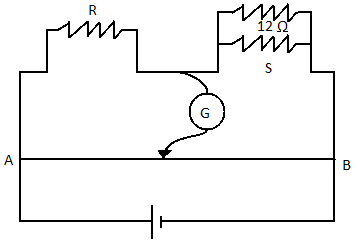
In a metre bridge the null point is found at a distance of 40cm from $A$. If a resistance of $12\Omega $ is connected in parallel with $S$, the null point occurs at $50cm$ from $A$. Determine value of $R$ and $S$.

Answer
216.3k+ views
Hint: Here two conditions are given, in one condition a resistance of $12\Omega $ is connected in parallel to $S$ and in another condition there is no such resistance connected in parallel. Applying the condition of Wheatstone bridge in these two conditions will give two different linear equations in form of variables of $R$ and $S$ . After solving the two equations you will get the answer.
Complete step by step solution:
Here in this question two conditions are given,
First, when a resistance of $12\Omega $ is not connected in parallel to $S$ . In that case we can write,
$\dfrac{R}{S} = \dfrac{{{l_1}}}{{(100 - {l_1})}}$
Putting ${l_1} = 40cm$ as given in the question we have,
$\dfrac{R}{S} = \dfrac{{40}}{{100 - 40}}$
So the relation between $R$ and $S$ is given by,
$R = \dfrac{2}{3}S$
Now case second when $12\Omega $ resistance is connected in parallel to the resistor $S$ .
In this case the effective resistance can be written as,
$\dfrac{1}{{{S_1}}} = \dfrac{1}{S} + \dfrac{1}{{12}}$
On simplifying this expression we have,
$\dfrac{1}{{{S_1}}} = \dfrac{{12 + 5}}{{12S}}$
Taking reciprocals on both sides we have,
${S_1} = \dfrac{{12S}}{{(12 + 5)}}$
Now writing the condition of Wheatstone bridge we have,
$\dfrac{R}{{{S_1}}} = \dfrac{{{l'}}}{{100 - {l'}}}$
Putting the expression for ${S_1}$ we have,
$R = \dfrac{{12S}}{{(12 + S)}} \times \dfrac{{50}}{{50}}$
On simplifying the above expression we have,
$R = \dfrac{{12S}}{{12 + S}}$
Now we have two expressions for $R$ after equating them we have,
$\dfrac{2}{3}S = \dfrac{{12S}}{{(12 + S)}}$
On simplifying the above expression we have,
$12 + S = 18$
So we have, $S = 6\Omega $
So we have $R = \dfrac{2}{3} \times 6 = 4\Omega $
So, the values of $R$ and $S$ are $4\Omega $ and $6\Omega $ respectively.
Note: It is important to note the working principle of a meter bridge. A meter bridge is an instrument that works on the principle of a Wheatstone bridge. A meter bridge is used in finding the unknown resistance of a conductor as that of in a Wheatstone bridge. The null point of a Wheatstone is also known as the balance point of the Wheatstone bridge.
Complete step by step solution:
Here in this question two conditions are given,
First, when a resistance of $12\Omega $ is not connected in parallel to $S$ . In that case we can write,
$\dfrac{R}{S} = \dfrac{{{l_1}}}{{(100 - {l_1})}}$
Putting ${l_1} = 40cm$ as given in the question we have,
$\dfrac{R}{S} = \dfrac{{40}}{{100 - 40}}$
So the relation between $R$ and $S$ is given by,
$R = \dfrac{2}{3}S$
Now case second when $12\Omega $ resistance is connected in parallel to the resistor $S$ .
In this case the effective resistance can be written as,
$\dfrac{1}{{{S_1}}} = \dfrac{1}{S} + \dfrac{1}{{12}}$
On simplifying this expression we have,
$\dfrac{1}{{{S_1}}} = \dfrac{{12 + 5}}{{12S}}$
Taking reciprocals on both sides we have,
${S_1} = \dfrac{{12S}}{{(12 + 5)}}$
Now writing the condition of Wheatstone bridge we have,
$\dfrac{R}{{{S_1}}} = \dfrac{{{l'}}}{{100 - {l'}}}$
Putting the expression for ${S_1}$ we have,
$R = \dfrac{{12S}}{{(12 + S)}} \times \dfrac{{50}}{{50}}$
On simplifying the above expression we have,
$R = \dfrac{{12S}}{{12 + S}}$
Now we have two expressions for $R$ after equating them we have,
$\dfrac{2}{3}S = \dfrac{{12S}}{{(12 + S)}}$
On simplifying the above expression we have,
$12 + S = 18$
So we have, $S = 6\Omega $
So we have $R = \dfrac{2}{3} \times 6 = 4\Omega $
So, the values of $R$ and $S$ are $4\Omega $ and $6\Omega $ respectively.
Note: It is important to note the working principle of a meter bridge. A meter bridge is an instrument that works on the principle of a Wheatstone bridge. A meter bridge is used in finding the unknown resistance of a conductor as that of in a Wheatstone bridge. The null point of a Wheatstone is also known as the balance point of the Wheatstone bridge.
Recently Updated Pages
Wheatstone Bridge Explained: Working, Formula & Uses

Young’s Double Slit Experiment Derivation Explained

JEE Atomic Structure and Chemical Bonding important Concepts and Tips

JEE Amino Acids and Peptides Important Concepts and Tips for Exam Preparation

Electricity and Magnetism Explained: Key Concepts & Applications

Chemical Properties of Hydrogen - Important Concepts for JEE Exam Preparation

Trending doubts
JEE Main 2026: Application Form Open, Exam Dates, Syllabus, Eligibility & Question Papers

Derivation of Equation of Trajectory Explained for Students

Hybridisation in Chemistry – Concept, Types & Applications

Understanding the Angle of Deviation in a Prism

Understanding Collisions: Types and Examples for Students

How to Convert a Galvanometer into an Ammeter or Voltmeter

Other Pages
JEE Advanced Marks vs Ranks 2025: Understanding Category-wise Qualifying Marks and Previous Year Cut-offs

Ideal and Non-Ideal Solutions Explained for Class 12 Chemistry

Degree of Dissociation: Meaning, Formula, Calculation & Uses

Understanding Electromagnetic Waves and Their Importance

Understanding the Electric Field of a Uniformly Charged Ring

Understanding Average and RMS Value in Electrical Circuits




